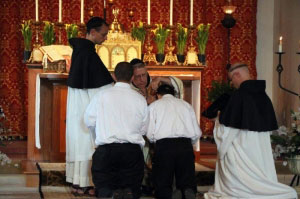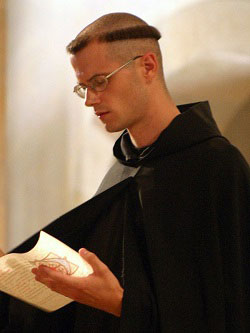

|
| Musical Musings: Miscellaneous |
|
|
Ritual TonsureThis article is reprinted from Lauda, Jerusalem, the newsletter of the Canons Regular of the New Jerusalem. The following is an excerpt from the sermon preached at the Vestition of the new Fraters Godfrey and Ephrem on the Feast of Corpus Christi, Thursday, May 31, 2018. It is reprinted with the permission of the author.
Beloved, regular canons are by nature priests, men ordained to a specific liturgical and pastoral mission within the Church. As such they have a singular devotion to the Mother of God, for she is, as the Second Vatican Council teaches, also Mother of the Church. It is within the hallowed womb of Holy Church that the priestly vocation of service to Mary's Son is nurtured and realized. The ceremonies which surround vestition in the habit of canonical life are expressive of the most ancient ascetic practices of Catholic Christianity. The first of the ceremonies is that of Monastic Tonsure. What does this rite signify? What does it effect? Saint Paul urges the Christian to strive for the prize of eternal life in the same way as the athlete who trains with single determination in order to gain a crown of laurel leaves for his physical prowess. In Roman tines such a crown was called a Bravium. Paul makes the comparison by saying that if an athlete strives with such diligence to receive a crown of human glory destined to fade, ought not the Christian strive with more determination to achieve that crown of glory which fadeth never? Beloved, professing the Christian faith is meaningless unless we allow God to penetrate every aspect of our life, mind, will and conduct. We must, therefore, act with complete moral integrity and constancy of purpose in striving towards that supernatural destiny which Christ — not modern man — sets before us as life's truest goal. In the ritual act of Tonsure a man's hair is cut in the shape of a crown by the incision of five marks representing the Five Glorious Wounds of Christ Our Redeemer. Afterwards, the head will then be shaved as an enduring sign of this sacramental rite. But isn't this just an anachronism in our modern world? No, it is not. Man is not simply rational: he is a composite being endowed with God-given senses each leading the human person, in one way or another, from that which is seen to that which is unseen. It is for this reason that authentic Christian worship is graced with the richness of our true, human culture: the majesty of music, the glitter of lights, the sweetness of perfumes. This panoply of light, line and color is expressive of ritual prayer redolent of a profound culture far more cognizant of true human need than our own. Such signs are necessary to us because they fulfill the needs of our human nature, sanctified, as it has been, by God's own sharing in it. Such things are necessary means by which we remind ourselves — and others — of what we believe in our hearts. The loss of such signs has, without any doubt, greatly contributed to an inestimable loss of supernatural faith within the Christianity of our times. The Tonsure is one such sign. It reminds the one wearing it (as well as those seeing it) that this man is consecrated in a particular way to the service of Jesus Christ. The priest, of whom the regular canon is a reformed expression, has, from the dawn of Christianity, been marked with this and other outward signs indicative of his being separated from others. Priests are not lay people, and they should be distinguished exteriorly from them — just as they are surely distinguished from them in the indelible marks upon their souls. The crown of Tonsure borne on the body is a sign to those who are still pilgrims in this present life of the eternal crown for which we all must strive. Above all and before all, it is a sign that priests must maintain a radical purity of intention in their hearts, in their love of Christ, and service to His Church. Priests are ordained to love God with undivided hearts and to singularly love and serve the Church — His Bride — for whom He has shed His precious blood. Therefore it is fitting — and has always been the practice — that priests live and act in a way that is distinct from everyone else. Priests are not, I repeat, lay persons (who have a vocation and way of life proper to themselves). The lay vocation is not the priestly vocation; it is necessary that this distinction be actual and not merely a passing speculative consideration. Catholic priests are the reality for which the Levitical priesthood of the Old Testament was the shadow. Priests must imitate, profoundly and intimately, the one, eternal Priest Who is Christ the Lord. If He, poor, chaste and obedient, saw fit to live in absolute poverty, willingly bear the most unspeakable sufferings for the salvation of the world, ought not His priests live and work with the same singleness of purpose? The Church has always held this ideal before her ministers and has instituted many ascetic practices which guide and lead the clergy onto just such a path towards holiness. All this is why the Tonsure is being conferred, even in so-called modern 2018. And among much else, conferring the Tonsure fulfills the Second Vatican Council's calling for the restoration of authentic sources in liturgical expression: the sign of the Roman slave was the shaved head.
Homily preached 31 May 2018
Also see CNP article:
|
Submit Your Music / Contact Us / Company Description / Links
 Beloved in Christ: We are about to witness the new birth in a certain sense of two men wishing to consecrate themselves with singleness of purpose to the service of Christ, His Church, the Priesthood, Catholic faith and witness.
And even though I am addressing these words of exhortation to our postulants, they apply to all who wish to deepen their own commitment to the universal call to holiness and Christ-centered living.
Beloved in Christ: We are about to witness the new birth in a certain sense of two men wishing to consecrate themselves with singleness of purpose to the service of Christ, His Church, the Priesthood, Catholic faith and witness.
And even though I am addressing these words of exhortation to our postulants, they apply to all who wish to deepen their own commitment to the universal call to holiness and Christ-centered living.
 When mediocrity began to set in after the legalization of Christianity in the 4th century — it had then become economically advantageous to be a Christian — many of the faithful felt a call to imitate Christ more perfectly.
Thus was born the first great waves of religious consecration in the form of the desert ascetics.
They shaved their heads as a sign of their slavery unto Christ.
In the rich sacramental development of the Middle Ages this practice took the form of the Cronoa — the Crown — a ring of hair circling the shaved skull and mystogogically representing the Crown of Thorns.
It was worn by priests and other ascetics (who were not ordained) as both sought the eternal crown through their spiritual struggle of renouncing all that hindered them in their pursuit of a perfect Christian service.
While a good deal of this has been forgotten, none of its Christian significance is outdated.
When mediocrity began to set in after the legalization of Christianity in the 4th century — it had then become economically advantageous to be a Christian — many of the faithful felt a call to imitate Christ more perfectly.
Thus was born the first great waves of religious consecration in the form of the desert ascetics.
They shaved their heads as a sign of their slavery unto Christ.
In the rich sacramental development of the Middle Ages this practice took the form of the Cronoa — the Crown — a ring of hair circling the shaved skull and mystogogically representing the Crown of Thorns.
It was worn by priests and other ascetics (who were not ordained) as both sought the eternal crown through their spiritual struggle of renouncing all that hindered them in their pursuit of a perfect Christian service.
While a good deal of this has been forgotten, none of its Christian significance is outdated.